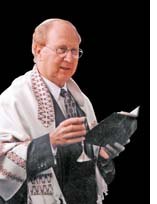|
By Cantor Sheldon F. Merel
 SAN DIEGO—The drama of the Kol Nidre ceremony begins on Yom Kippur evening, the holiest day of the Jewish year. The ark is opened, the rabbis and officers of the synagogue remove the white clad Torahs from the ark and the congregation rises as the cantor and choir begin to chant the stirring music of the Kol Nidre. As the echoes of the Kol Nidre finish reverberating in the sanctuary, the Torahs are returned to the ark, and then the Yom Kippur evening worship service begins! SAN DIEGO—The drama of the Kol Nidre ceremony begins on Yom Kippur evening, the holiest day of the Jewish year. The ark is opened, the rabbis and officers of the synagogue remove the white clad Torahs from the ark and the congregation rises as the cantor and choir begin to chant the stirring music of the Kol Nidre. As the echoes of the Kol Nidre finish reverberating in the sanctuary, the Torahs are returned to the ark, and then the Yom Kippur evening worship service begins!
… And then the Yom Kippur evening service begins!! So why does the climactic chanting of the Kol Nidre precede the actual beginning of the service, rather than placed in the middle or the end of the service? Because it is actually not a prayer, but rather a legal declaration that originated in the eighth century as a Talmudic tractate, (Nedarim) written in Aramaic (like the Kaddish). It was created so that Jews could seek forgiveness for broken vows made to God by reciting the words of a legal formula, Kol Nidre (three times) before a religious court, (Bet Din). It was intended to help Jews “clear the deck of their broken promises to God” before the eve of Yom Kippur. Through the centuries, this ritual was eventually placed into the service, just before the beginning of the Yom Kippur evening service, and as its popularity grew, music was slowly added to enrich the words.
Through the years the chanting of the Kol Nidre, has become almost more popular than its text, and even its name attached to the evening service. Kol Nidre, with its majestic cantorial singing has become so universally loved, that Jews rush to “shul” in time to hear it chanted. Although there are many other popular melodies in our worship services, none have captured the same spiritual and mystic appeal as the Kol Nidre!
It is important to note that the Mishna clearly teaches that recitation of the Kol Nidre legal text is not intended to release one from broken obligations made with his fellow men, “forgiveness must be sought directly from the person so
Go to the top of next column
|
|
wronged." Therefore, it is appropriate to ask family and friends during these Holy Days to forgive you if you have, in any way, offended them.
There are two versions of the Kol Nidre text; one recited in Ashkenazic congregations, renouncing oaths broken between last Yom Kippur and this one. Sephardic congregations, however, renounce broken promises between this Yom Kippur and the next. During the Spanish Inquisition of the 15th century, the latter version was created for Spanish Jews, who upon pain of death converted to Christianity. Many became secret Jews, and if they chose to participate in clandestine Yom Kippur services, reciting the Kol Nidre formula gave them some solace, for living outwardly as Christians.
Musicologists trace the beginnings of the popular Ashkenazic melody back to the 15th century. Its music development proceeded slowly through the centuries from country to country, and various composers combined several ancient musical sources; liturgy, biblical cantillations, and even songs of German troubadours. By the 19th century, the Kol Nidre melody was finally set, and travelling professional cantors carried it to countless Ashkenazic synagogues throughout Germany and northern Europe. In traditional congregations, Kol Nidre is chanted three times, and to avoid boredom, is sung a trifle higher and stronger with each repetition. Most Reform cantors chant Kol Nidre once, usually with choir and instrumental accompaniment.
Sephardic musical versions of Kol Nidre range from fairly simple chants from the Babylonian (Iraqi) tradition to a whispered chant with no melody at all. In the Carpentras (Provencal) tradition of southern France, it is a fairly elaborate melody influenced by Spanish-Portuguese Jews, and stylistically reminiscent of the Ashkenazic tune.
Although chanted once a year, the Kol Nidre’s mystic ritual, aura, drama and melody continues to capture the imagination of the Jewish community.
Shana Tovah.
|
|

